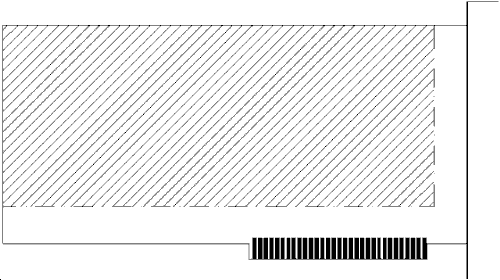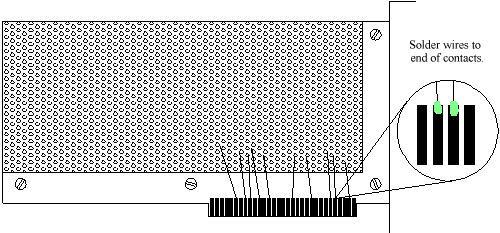Those who have built their own ISA bus cards know that the commercial ISA bus prototyping cards currently available are rather expensive ($15 +). If you are looking for an inexpensive, effective alternative, keep reading. I have personally used this method several times for my own ISA cards, and the cards function perfectly.
First, locate an old ISA card which you don't need anymore. I always keep non-functional cards around especially for this purpose. They can be picked up for pennies from rummage sales, HAM radio swap meets, etc. Now, you are going to use this card as a framework for your card. To do this, you need to cut away a large chunk of the existing circuit board in order to make room your circuitry. I use standard electronic prototyping perf board (available many places) to build my custom circuitry.
When you cut away the existing circuit board, be sure to leave enough of the old board along the bottom and side edge (as shown in the diagram) so that you have a firm place to attach the new board.
Next, ALL of the existing traces going to the edge connector fingers must be cut. Cut them as close to the contact finger as possible, and make sure the cuts are clean. We cannot afford to have these old traces make contact with something bad. I use the thin cutting wheel that comes with Dremel rotary tools to do the job. It is fast and clean. Alternatively, a sharp chisel or pocket knife can be used to scrape away the thin copper traces.
Now, you need to replace the cut away section of board with your own board. I always use perfboard, but an actual printed circuit board could be used also. After all, the point of this whole exercise is simply to utilize the existing card edge connector and mounting bracket. I use machine screws and nuts to fasten perf board to the part of the original board that we left intact. This is depicted in the diagram below.
|
|
Now, you can build your own custom circuitry on the perf board. The ISA bus signals can be accessed by running wires from the perf board area to the contact fingers. Carfully solder the wires to the top edge of the contact fingers. Be sure to use small wire. The following diagram illustrates this.
Try to make the solder connections to the contact fingers as small as possible. This is necessary because large, bulky solder connections will prevent the card from fitting nicely into the ISA bus slot. If the connections are small and only at the top of the finger, a reliable connection is ensured.
A further option is to remove the connectors currently on the mounting bracket and replace them with your own. For instance, the old DB25 connector could be removed from an old printer card, and a new solder cup style DB25 connector could be mounted in its place. This lets you run wires outside the computer in a neat, orderly way.
Well, that's about all there is to it. Feel free to e-mail any comments/questions to



